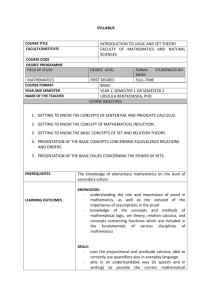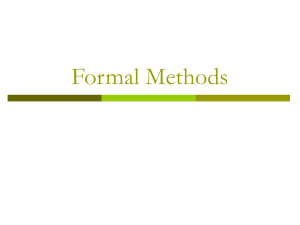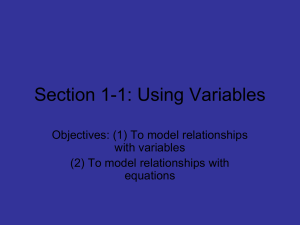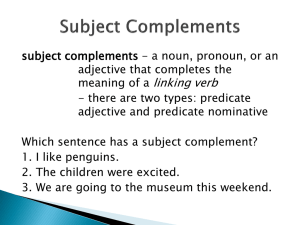THE PREDICATE
advertisement
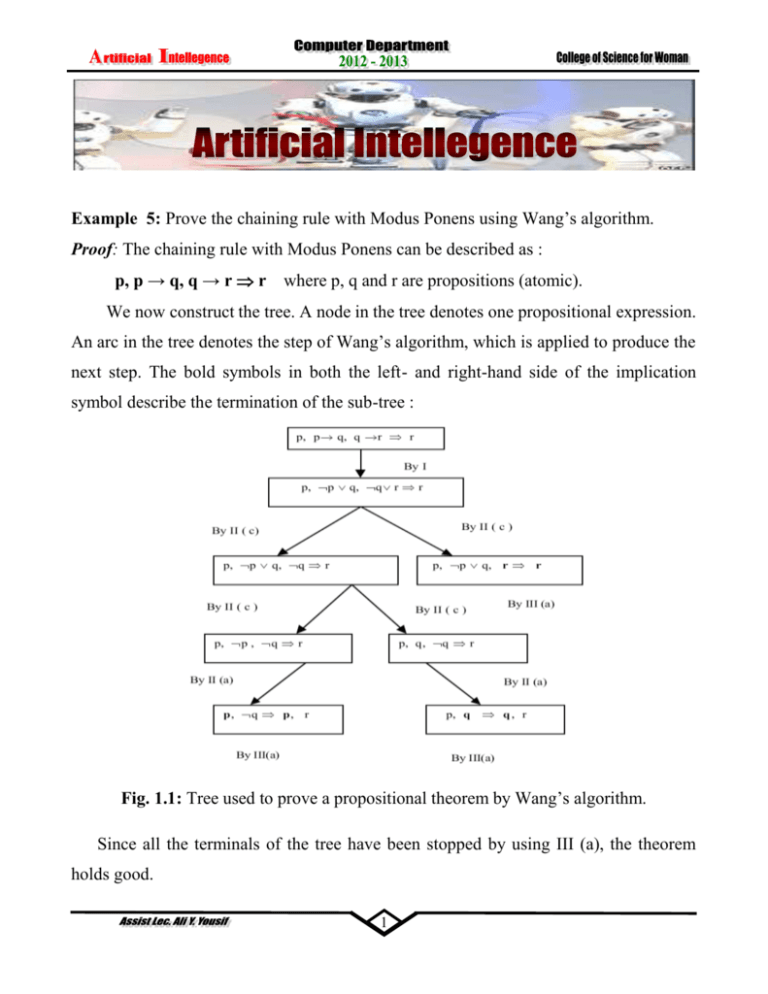
Example 5: Prove the chaining rule with Modus Ponens using Wang’s algorithm. Proof: The chaining rule with Modus Ponens can be described as : p, p → q, q → r r where p, q and r are propositions (atomic). We now construct the tree. A node in the tree denotes one propositional expression. An arc in the tree denotes the step of Wang’s algorithm, which is applied to produce the next step. The bold symbols in both the left- and right-hand side of the implication symbol describe the termination of the sub-tree : Fig. 1.1: Tree used to prove a propositional theorem by Wang’s algorithm. Since all the terminals of the tree have been stopped by using III (a), the theorem holds good. 1 PREDICATE CALCULUS 1.2 The Predicate Calculus : In propositional calculus, each atomic symbol (P, Q, etc.) denotes a proposition of some complexity. There is no way to access the components of an individual assertion. Predicate calculus provides this ability. For example, instead of letting a single propositional symbol, P, denote the entire sentence "it rained on Tuesday," we can create a predicate weather that describes a relationship between a date and the weather: weather(tuesday, rain). Through inference rules we can manipulate predicate calculus expressions, accessing their individual components and inferring new sentences. Predicate calculus also allows expressions to contain variables. Variables let us create general assertions about classes of entities. For example, we could state that for all values of X, where X is a day of the week, the statement weather(X, rain) is true; i.e., it rains every day. As with propositional calculus, we will first define the syntax of the language and then discuss its semantics. 1.2.1 The Syntax of Predicates and Sentences : Before defining the syntax of correct expressions in the predicate calculus, we define an alphabet and grammar for creating the symbols of the language. This corresponds to the lexical aspect of a programming language definition. Predicate calculus symbols, like the tokens in a programming language, are irreducible syntactic elements: they cannot be broken into their component parts by the operations of the language. In this text we represent predicate calculus symbols as strings of letters and digits beginning with a letter. Blanks and non-alphanumeric characters cannot appear within the string, although the underscore, _, may be used to improve readability. DEFINITIONS PREDICATE CALCULUS SYMBOLS The alphabet that makes up the symbols of the predicate calculus consists of: 1. The set of letters, both uppercase A..Z and lowercase a..z, of the English alphabet. 2. The set of digits, 0, 1, ... ,9. 3. The underscore, _. Symbols in the predicate calculus begin with a letter and are followed by any sequence of these legal characters. Legitimate characters in the alphabet of predicate calculus symbols include: 2 aR69p_z Examples of characters not in the alphabet include : # % @ / & "" Legal predicate calculus symbols include : George, fire3, tom_and_jerry, bill, XXXX, friends, of Examples of strings that are not legal symbols are : 3jack, "no blanks allowed", ab%cd, ***71, duck!!! Symbols are used to denote objects, properties, or relations in world of discourse. As with most programming languages, the use of "words" that suggest the symbol's intended meaning assists us in understanding program code. Thus, even though l(g, k) and likes(george, kate) are formally equivalent (i.e., they have the same structure), the second can be of great help (for human readers) in indicating what relationship the expression represents. It must be stressed that these descriptive names are intended solely to improve the readability of expressions. The only meaning that predicate calculus expressions may be said to have is through their formal semantics. Parentheses "( )", commas ",", and periods "." are used solely to construct wellformed expressions and do not denote objects or relations in the world. These are called improper symbols. Predicate calculus symbols may represent either variables, constants, functions, or predicates. Constants name specific objects or properties in the world. Constant symbols must begin with a lowercase letter. Thus george, tree, tall, and blue are examples of well-formed constant symbols. The constants true and false are reserved as truth symbols. Variable symbols are used to designate general classes of objects or properties in the world Variables are represented by symbols beginning with an uppercase letter. Thus George, BILL, and KAte are legal variables, whereas geORGE and bill are not. Predicate calculus also allows functions on objects in the world of discourse. Function symbols (like constants) begin with a lowercase letter. Functions denote a mapping of one or more elements in a set (called the domain of the function) into a unique element of another set (the range of the function). Elements of the domain and range are objects in the world of discourse. In addition to common arithmetic functions such as addition and multiplication, functions may define mappings between nonnumeric domains. Note that our definition of predicate calculus symbols does not include numbers or arithmetic operators. The number system is not included in the predicate calculus primitives; instead it is defined axiomatically using "pure" predicate calculus as a basis. While the particulars of this derivation are of theoretical interest. they are less important to the use of predicate calculus as an AI representation language. For convenience, we assume this derivation and include arithmetic in the language. 3 Every function symbol has an associated arity, indicating the number of elements in the domain mapped onto each element of the range. Thus father could denote a function of arity 1 that maps people onto their (unique) male parent. plus could be a function of arity 2 that maps two numbers onto their arithmetic sum. A function expression is a function symbol followed by its arguments. The arguments are elements from the domain of the function; the number of arguments is equal to the arity of the function. The arguments are enclosed in parentheses and separated by commas. For example: f(X,Y) father(john) price(bananas) are all well-formed function expressions. Each function expression denotes the mapping of the arguments onto a single object in the range, called the value of the function. For example, if father is a unary function, then : father(david) is a function expression whose value is george (i.e. george father of david). If plus is a function of arity 2, with domain the integers, then: plus(2,3) is a function expression whose value is the integer 5. The act of replacing a function with its value is called evaluation. The concept of a predicate calculus symbol or term is formalized in the following definition: 4



